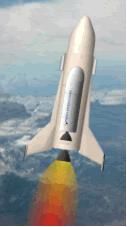
Home - Search - Browse - Alphabetic Index: 0- 1- 2- 3- 4- 5- 6- 7- 8- 9
A- B- C- D- E- F- G- H- I- J- K- L- M- N- O- P- Q- R- S- T- U- V- W- X- Y- Z
Ares FBB
 Ares Credit: USAF |
Status: Development. Payload: 6,000 kg (13,200 lb). Gross mass: 300,000 kg (660,000 lb). Apogee: 300 km (180 mi).
The United States Air Force embarked upon a demonstration program for the ARES launch system in May 2005. The ARES concept was developed specifically to create a transformational spacelift capability, embodying affordability, responsiveness, simplicity of operations, and reliability for a wide range of payload classes. This capability was to support tactically deployed space assets, as well as conventionally deployed satellites.
Based on experience gained from both operational and experimental vehicles, on government and industry studies, and a recently approved Operationally Responsive Spacelift (ORS) Analysis of Alternatives (AoA), the Air Force determined that this capability would take the form of a family of modular ARES launch vehicles. The ARES family of vehicles was to provide affordable responsive lift for all or most of the DoD payload manifest.
The ARES concept was that of a reusable fly-back booster with expendable upper stages. This concept was found to be highly responsive (24-48 hour turnaround), but to have lower costs generally than either fully expendable or fully reusable vehicles. The reason for this is that, for a given payload mass, the ARES concept expended relatively little hardware mass (about a third of a fully expendable vehicle), and required development of relatively little reusable hardware mass (about a third of a fully reusable vehicle).
The reference design for ARES in the ORS/AoA was a rocket plane medium-lift launch system, with upper stages carried piggyback and released 300 km from the launch base at Mach 7 and 60 km altitude. This release point and velocity precluded a glide back to the launch site, Jet engines would be used to fly the first stage back to base. The upper stages could be modifications of existing stages, or new lower-cost concepts under development under DARPA's Falcon launcher program.
The ARES specification called for the ability to launch a pre-integrated payload with 48 hours notice; a 48 hour turn-around after a prior launch; a 4500 kg to 7000 kg payload to low earth orbit; growth in derivative versions to 20,000 kg payload; a cost goal of $ 2200 per kilogram to orbit (one third of existing expendable launch vehicles); and a first flight date of the operational launcher in 2018.
The notional ARES vehicle would use vertical takeoff/horizontal landing and liquid oxygen/kerosene propellants for both the booster and its reaction control system (no corrosive/toxic storable propellants). The performance figures implied a gross lift-off mass of 200 to 360 metric tons (assuming a first stage vehicle with an 11% to 20% mass fraction, an engine specific impulse of 300 to 330 seconds, and an engine thrust/weight of 85:1). A notional vehicle with a 300 metric ton gross lift-off mass and an 11.5% first stage mass fraction would have a six metric ton payload, a 240 metric ton first stage, and 60 metric tons of upper stages and payload.
The Air Force called for concept studies for development of a 25% subscale ARES-SD demonstration vehicle and associated ground hardware to conduct flight demonstrations in 2010. The goals of the demonstrator were to: 1) reduce technical integration risks; 2) provide data for high-confidence estimates of full scale system cost and operability; and 3) demonstrate Air Force's ability to field the system in a timely and affordable fashion. The demonstration program was a joint effort between Air Force Space Command and the Air Force Research Lab, which jointly had $280 million budgeted for the effort in the 2005-2011 period.
Phase 1 concept studies would be funded to run through June 2006. They would be followed by award of Phase 2/3 contracts at the end of 2006 to build and fly the demonstrator.
LEO Payload: 6,000 kg (13,200 lb) to a 300 km orbit at 28.50 degrees. Launch Price $: 6.000 million in 2005 dollars.
Family: orbital launch vehicle, Winged. Country: USA. Spacecraft: Mars Oz, Orion.
Back to top of page
Home - Search - Browse - Alphabetic Index: 0- 1- 2- 3- 4- 5- 6- 7- 8- 9
A- B- C- D- E- F- G- H- I- J- K- L- M- N- O- P- Q- R- S- T- U- V- W- X- Y- Z
© 1997-2019 Mark Wade - Contact
© / Conditions for Use